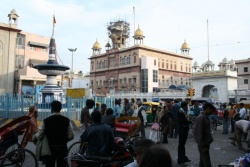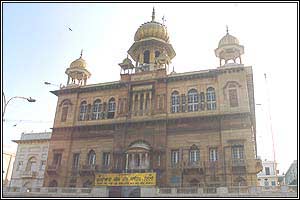Gurdwara Sis Ganj Sahib
Gurdwara Sis Ganj Sahib is built at the site in the Chandni Chowk area of Old Delhi, where the ninth Sikh Guru, Guru Tegh Bahadur was beheaded, in 1675, on the orders of the Mughal emperor Aurangzeb for refusing to convert to Islam. Before his body could be quartered and exposed to public view, it was stolen under the cover of darkness by one of his disciples, Lakhi Shah Vanjara, who then sat his home afire to cremate the Guru's body.
The 'Sis' (severed head) of Guru Tegh Bahadur was taken to Anandpur Sahib by Bhai Jaita, another devotee of the Guru where it was cremated by the Guru's young son, Guru Gobind Rai.
Bhai Jaita who had been of the Majhabi (scavenger) caste, was renamed Bhai Jivan Singh on the same day that Guru Gobind Rai created the Khalsa and added the names Singh and Kaur to the names of all Sikhs. Guru Gobind Singh was the tenth and last Guru, in human form, of the Sikhs.
The Chandni Chowk area has, as well, another Gurdwara, Gurdwara Rakab Ganj Sahib.
The twin city of Delhi and New Delhi is not only the capital of India, but also has become the central place and the pivot of all political activities. It has gained importance since Independence as the seat of the biggest democracy of the world.
There are nine historic Gurdwaras, associated with important events, which had a great bearing on the history of Punjab and changed its course and direction. Consequently it became a renowned place of pilgrimage, being the sacred city, as the five Gurus visited the capital. Various Gurdwaras have been constructed to commemorate their visits. Thousands of pilgrims throng these holy shrines everyday to listen to kirtan (devotional music) from Granth Sahib. Of the ten Sikh Gurus, at least five, namely Nanak Dev, Hargobind, Harkrishan, Tegh Bahadur and Gobind Singh visited Delhi. Guru Tegh Bahadur the ninth Guru was beheaded in Chandni Chowk by the. order of Mughal Emperor Aurangzeb. Earlier the eighth Guru Harkrishan died of smallpox during his visit to Delhi.
Two wives of Guru Gobind Singh, Mata Sundri and Mata Sahib Kaur lived in Delhi for 35 years after his death and they issued directions to the Sikh forces from Gurdwara Mata Sundari, Delhi. This Gurdwara near the Turkman Gate was built to perpetuate their memory. After the death of the last Guru, Gobind Singh at Nanded (Hazur Sahib) in Maharashtra, his disciple Baba Banda Bahadur camped in the neighbourhood of Delhi and chalked out his programme to attack the Mughal forces,in Punjab. The village Budhkhalsa where he stayed, is situated along the Grand Trunk Road (Shershah Suri Marg). This great Sikh hero shook the Mughal Empire in Punjab, gave crushing blows to the Imperial Army and captured the tract of land, lying between Yamuna and Sutlej. After his defeat in 1716, Banda Bahadur was brought to Delhi as a prisoner along with 1,000 followers, who were beheaded in Gandhi ground opposite Old Delhi Railway Station at a site known as, Qaza1-Gahe Sikhan. Harding Library now renamed as Hardyal Library stands on this site today. Over 100 Sikhs were killed daily for about 100 days. Banda Bahadur too was tortured to death near Qutab Minar situated in Mehrauli, a suburb of Delhi. Two stone pillars of a gateway overlooking the Dargah of Khwaja Bakhtiar Kakistill stand as a witness to the martyrdom of Baba Banda Bahadur, the army commander of Guru Gobind Singh. The 50 ft high pillar made of stone with a steep stains, now houses a Gurdwara in memory of the supreme sacrifice made by the valiant Sikh hero. Many a people visit this historical shrine to pay their respect to the great martyr.
Sardar Bhagel Singh, commander of the Kironsinghia Misal, who held Delhi under his sway for some months in 1783,during the time of Shah Alam ll took special pains to locate the sites of historical shrines. He made great contribution to the Sikh religion by constructing buildings, over all the historic sites in Delhi.
In March 1783, a large Sikh Army commanded by Jassa Singh Ahluwalia, Bhagel Singh Kironsinghia, Rai Singh Bhangi and Gurdit Singh, Raja of Ladwa, advanced to the imperial capital and attacked the Red Fort. Tis Hazari was so named by Bhagel Singh, because he had used the site as' stable for 30,000 horses of his cavalry.
The Mughal King opened negotiations. The Sikhs received Rs. three lakhs in cash as Nazrana and the permission to build their shrines on the historic sites, where mosques had been built. Bhagel Singh remained in Delhi as the head of 4,000 strong Sikh troops to build the Gurdwaras.
The ninth Guru Sri Tegh Bahadur, was beheaded in the heart of the city in 1675 A.D. by the order of Mughal King Aurangzeb, for espousing the cause off reedom of worship of the Hindus, against whom the Emperor had unleashed a war of extermination. Guru Tegh Bahadur opposed it and paid heavy price by sacrificing his life. At the place of his martyrdom, stands Gurdwara SisGanj,as a symbol of unique sacrifice made by the sage Prophet.
Adjoining the Gurdwara Sis Ganj is the Kotwali (police station), where the faithful disciples of the Great Guru Bhai Mati Das, Bhai Dyala and Bhai Sati Das were tortured to death.
It is important to mention that when the Sikhs came into power in Punjab,after pushing out Afghans, they fought pitched battles with the Mughal forces on the sandy beds of Yamuna river, where now stands Indraprastha Indoor Stadium. A small Gurdwara indicates the spot near the Indraprastha power station, where two forces clashed for supremacy.
The Secretary, Management Committee, Gurdwara Sis Ganj Sahib, Chandni Chowk, Delhi Pin Code 110 006
Phone NoS. : 91-11-3266589, 3285435
Their is also another Gurdwara at Anandpur Sahib called Gurdwara Sis Ganj Sahib.
| Gurus: | Nanak Dev | Guru Angad | Amar Das | Ram Das | Guru Arjan | Har Gobind | Har Rai | Har Krishan | Tegh Bahadur | Gobind Singh | Guru Granth Sahib | Sikh Bhagats |
| Philosophy: | Sikh Beliefs | Simran | Sewa | Beliefs and Principles | Underlying Values | Prohibitions | Technique and Methods | Other observations | Technique and Methods |
| Practices: | Ardas | Amrit Sanskar | Chardi Kala | Dasvandh | Five Ks | Kirat Karni | Kirtan | Langar | Naam Japna | Simran | Three Pillars | Vand Chakna | Five Evils | Five Virtues |
| Scripture: | Guru Granth Sahib | Sikh Scripture | Dasam Granth | Ek Onkar | Waheguru | Bani | Mool Mantar | Japji Sahib | Jaap Sahib | Chaupai | Anand Sahib | Tav-Prasad Savaiye | Rehras | Sukhmani |
| More: | History | Gurdwaras | Harmandir Sahib | Khalsa | Khanda | Names | Places | News | Satguru | Sikhs | Bhagat Farid | Bhagat Kabir | Websites | Biographical | Terms |


